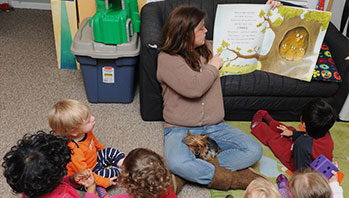- loud
- quiet
- soft
- sound
MA Standards:
Literature/RL.PK.MA.1: With prompting and support, ask and answer questions about a story or a poem read aloud.
Literature/RL.PK.MA.9: With prompting and support, make connections between a story or poem and one’s own experiences.
Head Start Outcomes:
Literacy Knowledge/Book Appreciation and Knowledge: Asks and answers questions and makes comments about print materials.
Logic and Reasoning/Reasoning and Problem Solving: Classifies, compares, and contrasts objects, events, and experiences.
Logic and Reasoning/Symbolic Representation: Engages in pretend play and acts out roles.
PreK Learning Guidelines:
English Language Arts/Reading and Literature 6: Listen to a wide variety of age appropriate literature read aloud.
English Language Arts/Reading and Literature 12: Listen to, recite, sing, and dramatize a variety of age-appropriate literature.
English Language Arts/Reading and Literature 13: Relate themes and information in books to personal experiences.
English Language Arts/Reading and Literature 15: Listen to, recognize, and use a broad vocabulary of sensory words.
Read Together: Night in the Country #2

© Commonwealth of Massachusetts, Department of Early Education and Care (Jennifer Waddell photographer). All rights reserved.
STEM Key Concepts: Sounds have a source; An action has to happen to make a sound; Different objects make different sounds; Sounds vary in three ways: volume, pitch, and timbre
ELA Focus Skills: Concepts of Print, Making Connections, Speaking and Listening, Vocabulary
Tell children you are going to read Night in the Country by Cynthia Rylant again. Set a reading focus by asking children to listen to and create different sounds in the story.
Before You Read
Hold up Night in the Country and ask a volunteer to locate the title. Point to each word as you read aloud the title and the names of the author and illustrator. As you hold up the book, discuss how children can use their voices, bodies, or objects to make some of the sounds in the book. Say,
- The screen door creaks. A creak is like a squeak. Let’s all use our voices to creak and squeak.
- The rabbits patter in the yard. They make soft, light sounds as they run. Let’s tap our thighs very fast with our hands. Can you hear the rabbits running?
- The house groans. A groan is a deep, low sound that you make in the back of your throat. Let me hear you groan.
As You Read
As you read, pause to give children time to use their voices, bodies, or objects to make the sounds of the frog singing, the dog’s chain clinking, the screen door creaking, the apple falling, and other sounds in the story.
After You Read
Ask children if they have ever heard any of the sounds you read about in the book.
- Where did you hear the sound?
- Can you describe the sound? Was it a loud or a quiet sound?
- How did you feel when you heard the sound?
